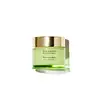What's inside
What's inside
 Key Ingredients
Key Ingredients

 Benefits
Benefits

 Concerns
Concerns

 Ingredients Side-by-side
Ingredients Side-by-side

Aloe Barbadensis Leaf Juice
Skin ConditioningPropanediol
SolventGluconolactone
Skin ConditioningGlycolic Acid
BufferingPentylene Glycol
Skin ConditioningWater
Skin ConditioningCaprylic/Capric Triglyceride
MaskingSodium Hydroxide
BufferingHydroxyethyl Acrylate/Sodium Acryloyldimethyl Taurate Copolymer
Emulsion StabilisingSodium Polyacryloyldimethyl Taurate
Emulsion StabilisingSorbus Aucuparia Fruit Extract
Skin ConditioningLactic Acid
BufferingSalicylic Acid
MaskingGluconic Acid
Sodium Hyaluronate
HumectantTocopherol
AntioxidantGlycerin
HumectantLactobacillus Ferment
Skin ConditioningRiboflavin
Cosmetic ColorantMica
Cosmetic ColorantSilica
AbrasiveXanthan Gum
EmulsifyingSodium Chloride
MaskingSodium Carbonate
BufferingPolycitronellol
Polysorbate 60
EmulsifyingSorbitan Isostearate
EmulsifyingPentaerythrityl Tetra-Di-T-Butyl Hydroxyhydrocinnamate
AntioxidantTetrasodium Glutamate Diacetate
Sodium Benzoate
MaskingEthylhexylglycerin
Skin ConditioningPhenoxyethanol
PreservativeParfum
MaskingLimonene
PerfumingCI 77891
Cosmetic ColorantAloe Barbadensis Leaf Juice, Propanediol, Gluconolactone, Glycolic Acid, Pentylene Glycol, Water, Caprylic/Capric Triglyceride, Sodium Hydroxide, Hydroxyethyl Acrylate/Sodium Acryloyldimethyl Taurate Copolymer, Sodium Polyacryloyldimethyl Taurate, Sorbus Aucuparia Fruit Extract, Lactic Acid, Salicylic Acid, Gluconic Acid, Sodium Hyaluronate, Tocopherol, Glycerin, Lactobacillus Ferment, Riboflavin, Mica, Silica, Xanthan Gum, Sodium Chloride, Sodium Carbonate, Polycitronellol, Polysorbate 60, Sorbitan Isostearate, Pentaerythrityl Tetra-Di-T-Butyl Hydroxyhydrocinnamate, Tetrasodium Glutamate Diacetate, Sodium Benzoate, Ethylhexylglycerin, Phenoxyethanol, Parfum, Limonene, CI 77891
Diglycerin
HumectantCalendula Officinalis Flower/Leaf/Stem Juice
Skin ConditioningPropanediol
SolventCetearyl Olivate
Water
Skin ConditioningSorbitan Olivate
EmulsifyingLactic Acid
BufferingLactobacillus Ferment
Skin ConditioningLeuconostoc Ferment Filtrate
AntimicrobialPhytic Acid
Saccharide Isomerate
HumectantKaolin
AbrasiveAlpha-Glucan Oligosaccharide
CleansingPassiflora Edulis Seed Oil
EmollientLavandula Angustifolia Extract
Skin ConditioningChamomilla Recutita Flower Extract
MaskingBorago Officinalis Leaf Extract
Skin ConditioningCalendula Officinalis Flower Extract
MaskingMedicago Sativa Extract
TonicHelianthus Annuus Seed Oil
EmollientCitric Acid
BufferingSodium Hydroxide
BufferingSodium Citrate
BufferingDiglycerin, Calendula Officinalis Flower/Leaf/Stem Juice, Propanediol, Cetearyl Olivate, Water, Sorbitan Olivate, Lactic Acid, Lactobacillus Ferment, Leuconostoc Ferment Filtrate, Phytic Acid, Saccharide Isomerate, Kaolin, Alpha-Glucan Oligosaccharide, Passiflora Edulis Seed Oil, Lavandula Angustifolia Extract, Chamomilla Recutita Flower Extract, Borago Officinalis Leaf Extract, Calendula Officinalis Flower Extract, Medicago Sativa Extract, Helianthus Annuus Seed Oil, Citric Acid, Sodium Hydroxide, Sodium Citrate
Ingredients Explained
These ingredients are found in both products.
Ingredients higher up in an ingredient list are typically present in a larger amount.
Lactic Acid is another well-loved alpha hydroxy acid (AHA). It is gentler than glycolic acid but still highly effective.
Its main role is to exfoliate the surface of the skin by loosening the “glue” that holds dead skin cells together. Shedding those old cells leads to smoother, softer, and more even-toned skin.
Because lactic acid molecules are larger than glycolic acid, they don’t penetrate as deeply. This means they’re less likely to sting or irritate, making it a great choice for beginners or those with sensitive skin.
Like glycolic acid, it can:
Lactic acid also acts as a humectant (like hyaluronic acid). It can draw water into the skin to improve hydration and also plays a role in the skin's natural moisturizing factor (NMF) in the form of sodium lactate.
Studies show it can boost ceramide production to strengthen the skin barrier and even help balance the skin’s microbiome.
To get results, choose products with a pH between 3-4.
Lower strengths (5-12%) focus on surface exfoliation; higher strengths (12% and up) can reach deeper in the dermis (deeper, supportive layer) to improve skin texture and firmness over time.
Though it was originally derived from milk, most modern lactic acid used in skincare is vegan. It is made through non-dairy fermentation to create a bio-identical and stable form suitable for all formulations.
When lactic acid shows up near the end of an ingredient list, it usually means the brand added just a tiny amount to adjust the product’s pH.
Legend has it that Cleopatra used to bathe in sour milk to help reduce wrinkles.
Lactic acid is truly a gentle multitasker: it exfoliates, hydrates, strengthens, and brightens. It's a great ingredient for giving your skin a smooth, glowing, and healthy look without the harshness of stronger acids.
Read more about some other popular AHA's here:
Learn more about Lactic AcidLactobacillus Ferment is created by fermenting the Lactobacillus bacteria. It helps keep our skin's natural barrier and microbiome healthy.
Studies show lactobacillus ferment to be effective at repairing the skin barrier. Having a healthy skin barrier helps keep your skin healthy and hydrated. It also protects against bad bacteria.
As a probiotic/prebiotic/postbiotic, Lactobacillus ferment can help regular our natural biome. In fact, one study found a lack of diversity in our natural skin biome can trigger acne.
Learn more about Lactobacillus FermentPropanediol is an all-star ingredient. It softens, hydrates, and smooths the skin.
It’s often used to:
Propanediol is not likely to cause sensitivity and considered safe to use. It is derived from corn or petroleum with a clear color and no scent.
Learn more about PropanediolSodium Hydroxide is also known as lye or caustic soda. It is used to adjust the pH of products; many ingredients require a specific pH to be effective.
In small amounts, sodium hydroxide is considered safe to use. However, large amounts may cause chemical burns due to its high alkaline.
Your skin has a natural pH and acid mantle. This acid mantle helps prevent harmful bacteria from breaking through. The acid mantle also helps keep your skin hydrated.
"Alkaline" refers to a high pH level. A low pH level would be considered acidic.
Learn more about Sodium HydroxideWater. It's the most common cosmetic ingredient of all. You'll usually see it at the top of ingredient lists, meaning that it makes up the largest part of the product.
So why is it so popular? Water most often acts as a solvent - this means that it helps dissolve other ingredients into the formulation.
You'll also recognize water as that liquid we all need to stay alive. If you see this, drink a glass of water. Stay hydrated!
Learn more about Water